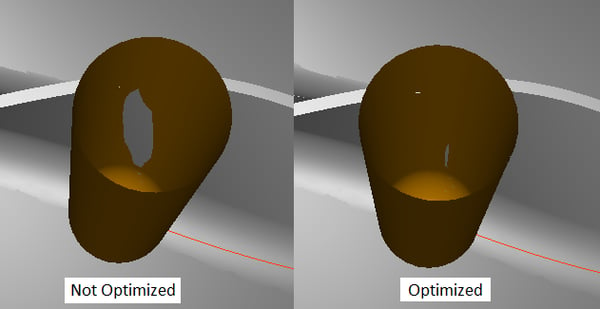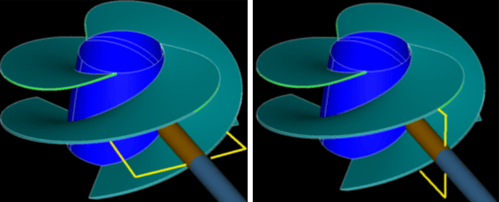MAX-5™
CAM Software for Flank Milling
MAX-5™ creates 5-axis CNC machining instructions for flank milling of ruled-surface turbomachinery components. Typical applications include parts for centrifugal compressors, pumps, inducers, fans, turbochargers, stators, radial-inflow turbines, expanders, and torque converters.

-
With MAX-5’s patented algorithm, dramatic cost savings can be realized using ruled-surface designs and production with a flank-milling process. Flank milling efficiently finishes the entire blade surface with one pass using the side of the cutter. Our algorithm analyzes and assesses the deviation for each blade and compensates for it to produce parts that meet very tight tolerances. The pictures below show views inside the tool to better view the reduced deviation:

-
Compared to other CAM systems, MAX-5 is often capable of generating flank milling toolpaths with an 80% to 90% error reduction with one pass on each side of the blade. The alternative, point milling with just the tool tip, requires many passes to leave a suitably small cusp height between passes. This dramatically increases the machining time of the part. The flank milling algorithm in MAX-5 also provides smooth machine motion without dangerous rotary spins that are a common pitfall of 5-axis machining.
-
MAX-5 supports ruled blade surfaces with optional non-ruled edge constructions. It also includes options for roughing, plunge milling, hub finish, flank-milled blade finish, leading edge, fillet finish, and tip milling.
With MAX-5’s patented algorithm, dramatic cost savings can be realized using ruled-surface designs and production with a flank-milling process. Flank milling efficiently finishes the entire blade surface with one pass using the side of the cutter. Our algorithm analyzes and assesses the deviation for each blade and compensates for it to produce parts that meet very tight tolerances. The pictures below show views inside the tool to better view the reduced deviation:

Compared to other CAM systems, MAX-5 is often capable of generating flank milling toolpaths with an 80% to 90% error reduction with one pass on each side of the blade. The alternative, point milling with just the tool tip, requires many passes to leave a suitably small cusp height between passes. This dramatically increases the machining time of the part. The flank milling algorithm in MAX-5 also provides smooth machine motion without dangerous rotary spins that are a common pitfall of 5-axis machining.
MAX-5 supports ruled blade surfaces with optional non-ruled edge constructions. It also includes options for roughing, plunge milling, hub finish, flank-milled blade finish, leading edge, fillet finish, and tip milling.

Flank Milling Optimization
With MAX-5’s patented algorithm, dramatic cost savings can be realized using ruled-surface designs and production with a flank-milling process. Flank milling efficiently finishes the entire blade surface with one pass using the side of the cutter. Our algorithm analyzes and assesses the deviation for each blade and compensates for it to produce parts that meet very tight tolerances. The pictures show views inside the tool to better view the reduced deviation.
MAX-5™ Advantages
Compared to other CAM systems, MAX-5 is often capable of generating flank milling toolpaths with an 80% to 90% error reduction with one pass on each side of the blade. The alternative, point milling with just the tool tip, requires many passes to leave a suitably small cusp height between passes. This dramatically increases the machining time of the part. The flank milling algorithm in MAX-5 also provides smooth machine motion without dangerous rotary spins that are a common pitfall of 5-axis machining.
MAX-5 supports ruled blade surfaces with optional non-ruled edge constructions. It also includes options for roughing, plunge milling, hub finish, flank-milled blade finish, leading edge, fillet finish, and tip milling.
Flank Milling Optimization
With MAX-5’s patented algorithm, dramatic cost savings can be realized using ruled-surface designs and production with a flank-milling process. Flank milling efficiently finishes the entire blade surface with one pass using the side of the cutter. Our algorithm analyzes and assesses the deviation for each blade and compensates for it to produce parts that meet very tight tolerances. The pictures below show views inside the tool to better view the reduced deviation:

MAX-5 Advantages
Compared to other CAM systems, MAX-5 is often capable of generating flank milling toolpaths with an 80% to 90% error reduction with one pass on each side of the blade. The alternative, point milling with just the tool tip, requires many passes to leave a suitably small cusp height between passes. This dramatically increases the machining time of the part. The flank milling algorithm in MAX-5 also provides smooth machine motion without dangerous rotary spins that are a common pitfall of 5-axis machining.
Advanced Capabilities
MAX-5 supports ruled blade surfaces with optional non-ruled edge constructions. It also includes options for roughing, plunge milling, hub finish, flank-milled blade finish, leading edge, fillet finish, and tip milling.
Software Highlights
2020 Release Features
Other MAX-PAC™ Add-On Modules
Select any combination to meet your specific machining requirements.
MAX-PAC Add-On Modules
Software Support

Customer-driven Improvement

Technical Support

Documentation

Find Your Rep
North America
Mr. Don Roberson
Phone:
Email: DRoberson@conceptsnrec.com
South America
Time is money. Save more of it.
Sprocket Rocket Theme helps you save countless hours by making sweeping charges across your entire site instantly.
EMEA
Responsive by nature and packed with SEO performance.
Creating mobile-friendly pages that load quickly and adhere to Google Core Web Vitals isn't just about getting a fast page speed score. It's great for your website visitors, too.
Sprocket Rocket Theme is lightweight and built to perform for desktop, tablet, and mobile device visitors.
Russia
Easy and fast adjustments of elements is possible with Core template. Find our more about our all-in-one programmatic template.
Great China & SE Asia
Easy and fast adjustments of elements is possible with Core template. Find our more about our all-in-one programmatic template.
India
Easy and fast adjustments of elements is possible with Core template. Find our more about our all-in-one programmatic template.
Japan
Easy and fast adjustments of elements is possible with Core template. Find our more about our all-in-one programmatic template.
South Korea
Easy and fast adjustments of elements is possible with Core template. Find our more about our all-in-one programmatic template.
CAM Software Workshops
2021 November CAM Software Workshop
Application-Based Learning
Date: October 18 - 29, 2021
Time: 9:30 am - 1:00 pm EDT
Course Fee: $3500 USD
This course is designed to help engineers design, test, and run pumps and systems that are more efficient, more economical, and more reliable. Engineers will come to understand the best state-of-the-art design practices and learn the latest theories on performance, cavitation, dynamic forces, and noise. The course will review the latest advances in design tools and will provide expert and relevant instruction to designers on pump design optimization. Nearly half of all the teaching is focused on actual commercial design cases with measured data for confirmation.
2021 Trade Show: ComVac Asia
Visit Concepts NREC China at the ComVac Asia
Date: October 26-29, 2021
Location: Shanghai, China
To learn more, visit https://www.comvac-asia.com/index.php?lang=en
Find Your Rep
Corporate Headquarters
217 Billings Farm Road
White River Junction, VT 05001-9486
Phone: 802-296-2321
Fax: 802-296-2325
Email: sales@conceptsnrec.com
North America Software Sales
Phone: 802-280-6181
Fax: 802-296-2325
Email: droberson@conceptsnrec.com
" Kinner Manufacturing was founded in 2007 with the goal to deliver the highest-quality bladed parts to our customers. To deliver on that goal, we needed the best CAM software available. As a machinist, I had worked with many CAM systems. I noticed that blades were always better when produced with Concepts NREC software, so we called them to set up a demo. Having never actually used the software to create a design, I was surprised at how intuitive it was. We decided to go with MAX-PAC™ and we were trained and creating programs right away.
As we grew, we noticed that a lot of our customers were creating their blade geometry using Concepts NREC’s CAE software. This makes for a seamless transition to the CAM software helping to ensure the original design intent. Having a suite of software that spans the whole process eliminates some of the issues that can happen when designs are switched between different programs.
Here at Kinner Manufacturing, we think that MAX-PAC is the best solution to the unique challenges of 5-axis machining of bladed components."
Ray Kinner, Owner










